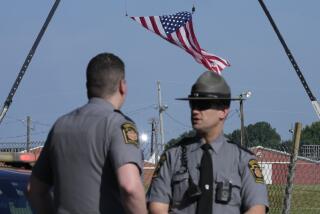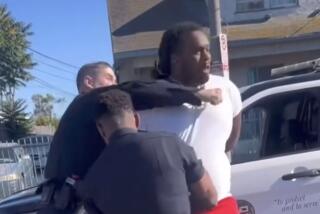Justice Department to assist in investigation of South Carolina cop
- Share via
reporting from Washington — The White House said Wednesday that a dramatic video showing a white police officer in South Carolina shooting and killing a black man as he ran away shows why police officers should wear body cameras.
The Justice Department and the FBI are now assisting state authorities in the investigation and prosecution, which follow a series of high-profile cases of police using lethal force in New Mexico, New York, Ohio, Missouri and elsewhere.
Josh Earnest, the White House spokesman, said the bystander’s shaky handheld video of North Charleston police Officer Michael T. Slager, 33, repeatedly shooting Walter L. Scott, 50, in the back changed how investigators viewed the case.
“That is an example of how body cameras worn by police officers could have a positive impact in terms of building trust between law enforcement officers and the communities that they serve,” Earnest said.
Earnest said he did not know if President Obama had seen the graphic video, which he described as “hard to watch.”
A White House policing panel recently recommended that law enforcement departments put more video cameras on their officers. Advocates say the cameras can help collect evidence, help deter abuse by officers, and help protect officers falsely charged with wrongdoing.
Slager was charged with murder after investigators reviewed the video, the latest in a series of shooting that have sparked protests and a national debate over whether police too often use deadly force, especially against African Americans.
FBI agents from the bureau’s South Carolina office have opened an investigation concurrent with one led by the state police, the S.C. Law Enforcement Division, “and are providing aid as necessary to the state investigation,” according to a Justice Department spokeswoman, Dena Iverson.
She also said prosecutors at the Justice Department’s Civil Rights Division, and the U.S. Attorney’s office in Columbia, S.C., will work with the FBI and “will take appropriate action in light of the evidence and developments in the state case.”
Legal experts said there appears to be strong evidence to bring federal charges against Slager if something goes wrong with the local prosecution, such as a failure to proceed with murder charges or an acquittal by a local jury.
Although the police officer is white and his victim black, federal prosecutors would not need to prove racial prejudice was a factor in the shooting, said William Yeomans, a former top official of the Civil Rights Division.
Yeomans, a law professor at American University in Washington, said it appeared the video would be enough to charge Slager with unreasonable use of force, a federal crime based on the 4th Amendment protection against unreasonable seizures.
“The video is just so overpowering,” Yeomans said, referring not only to the shooting of an apparently unarmed man but also the officer’s effort to move evidence at the crime scene.
Shortly after the attack, Slager picked up his police radio and reported, “Shots fired and the subject is down. He took my Taser,” according to police reports.
The video shows Slager jogging back to where he had fired his handgun, picking up an item from the ground, and then walking back and dropping it next to Scott as he lay wounded and bleeding on the grass.
Police have long escaped charges in questionable shootings by claiming self-defense. Cellphone cameras and a heightened public awareness have changed the dynamic and led to several recent investigations and prosecutions, experts said.
“If you are going to make a complaint against a police officer stick you really need video evidence so that you can present the facts in an indisputable way,” Yeomans said.
“Otherwise people are likely to believe the police officer. It’s the video that breaks through the blue wall of trust.”
More to Read
Sign up for Essential California
The most important California stories and recommendations in your inbox every morning.
You may occasionally receive promotional content from the Los Angeles Times.












